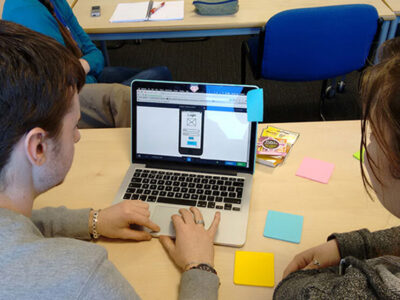Generative AI: Introduction and Overview eLearning
Deze eLearning biedt een uitgebreide introductie tot het vakgebied van Generatieve AI. Je begint met de basis en verkent de toepassingen, kernconcepten en deep learning-technieken van Generatieve AI. Vervolgens worden complexere onderwerpen behandeld, zoals geavanceerde methodologieën en ethische vraagstukken. De serie wordt afgesloten met een praktijkproject, waarbij je je opgedane kennis toepast om zelf een Generatieve AI-model te bouwen, wat zorgt voor een praktische leerervaring.
Deze leerreis is geschikt voor een breed scala aan deelnemers, van datawetenschappers en IT-managers tot nieuwkomers in het AI-veld, ongeacht hun locatie. Het programma is ontworpen voor professionals die hun kennis van Generatieve AI willen verdiepen en de mogelijkheden ervan willen benutten binnen hun branche, wat zowel persoonlijke als organisatorische groei ondersteunt.
Overview
COURSE DESCRIPTION
The “Generative AI: Introduction and Overview” learning provides an introduction to the field of Generative AI. Beginning with the basics, learners will explore the applications, key concepts, and deep learning techniques of Generative AI, progressing towards more complex topics like advanced methodologies and ethical issues. The series ends in a practical project where learners can apply their acquired knowledge to build a Generative AI model, providing a hands-on experience that reinforces theoretical learning.
Designed to cater to a diverse range of learners, this educational journey is ideal for anyone from data scientists and IT managers to newcomers in the AI field across different geographies. This journey is suited for professionals looking to deepen their understanding of Generative AI and leverage its capabilities within their respective industries, enhancing both their personal and organizational growth.
- 12 Months Online Access
- 13+ hours of eLearning
- 1 Assessment
- 8 courses
Generative AI Overview
In this track, the focus will be on applications, key concepts, and deep learning techniques of Generative AI, progressing towards more complex topics like advanced methodologies and ethical issues. The series ends in a practical project where learners can apply their acquired knowledge to build a Generative AI model, providing a hands-on experience that reinforces theoretical learning.
- An Introduction to Generative AI
You’ll begin this course with an overview of generative. You will explore some notable examples of generative models, including OpenAI’s ChatGPT and Google Bard. Next, you will look at the use of prompt engineering when interacting with AI chatbots. Then, you will then delve into the history and evolution of generative AI models including important milestones that culminated in the conversational agents that we work with today. - Generative AI Models: Getting Started with Autoencoders
Begin this course off by exploring autoencoders, learning about the functions of the encoder and the decoder in the model. Next, you will learn how to create and train an autoencoder, using the Google Colab environment. Then you will use PyTorch to create the neural networks for the autoencoder, and you will train the model to reconstruct high-dimensional, grayscale images. - Generative AI Models: Generating Data Using Variational Autoencoders
Begin this course by discovering how variational autoencoders can be used for generating images. Next, you will create and train VAEs in Python and the Google Colab environment. Then you will construct the encoder and decoder. Finally, you will train the VAE on multichannel color images. - Generative AI Models: Generating Data Using Generative Adversarial Networks
Begin this course by discovering GANs, including the basic architecture of a GAN, which involves two neural networks competing in a zero-sum game – the generator and the discriminator. Next, you will explore how to construct and train a GAN using PyTorch framework to create and train the models. You’ll define the generator and discriminator separately, and then kick off the model training. - Using OpenAI APIs: Exploring APIs with the OpenAI Playground
You will start this course by exploring the fundamentals of OpenAI models. Next, you will log into the OpenAI Playground and input basic prompts, observing the responses. You will work with multiple application programming interfaces (APIs), including the recommended chat completions API and the legacy completions API, all of which are accessible via the playground. - Using OpenAI APIs: Accessing OpenAI APIs from Python
Start this course by engaging with OpenAI through the command-line, utilizing the OpenAI APIs. Learn how to authenticate yourself using API keys when programmatically accessing API endpoints using cURL commands. You will explore how to configure context for past interactions with the model and access both chat completions and legacy completions APIs via their respective endpoints. - Using OpenAI APIs: Using Image & Audio APIs
You will begin this course by generating images using OpenAI’s DALL-E model. You will generate images using text prompts, create variations of existing images, and perform image inpainting using natural language. Then, you will work with the Whisper model, which caters to speech transcription and translation. - Using OpenAI APIs: Fine-tuning Models, the Assistants API, & Embeddings.
Begin this course by creating prompt-completion pairs for fine-tuning, running a fine-tuning job, and observing the model’s performance. You will send prompts based on the training data and examine the model’s attempt to answer questions. Next, you will dive into connecting with the Assistants API programmatically. - Assessment:
Final Exam: Generative AI Introduction and Overview






